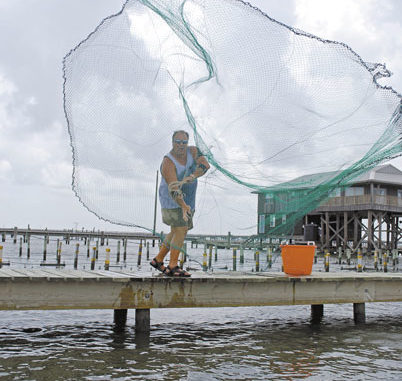
Among the most common as well as most poorly regarded fish species in Louisiana coastal waters are mullets. The term is used in plural because at least three and possibly four of the six Atlantic mullet species can be found in the state.
Most common is the striped mullet. Its scientific name, Mugil cephalus, interprets from Latin as “fish pertaining to the head.” They do indeed have a prominently hard bony head, as anyone who has been beaned by a jumping mullet at night can attest.
Less common, but not rare in Louisiana, is the white mullet, Mugil curema. They are smaller than the striped mullet, which can grow to over 2 pounds. (The world record is a 14-pound fish taken from a landlocked freshwater pond in Texas.) True to their names, adult striped mullet are silvery-white with prominent black longitudinal stripes, and white mullet are simply silvery-white.
Unfortunately, striped mullet don’t develop their stripes until they are about 8 inches long, close to the maximum size for white mullets, so the two can be difficult to tell apart. A determined amateur ichthyologist can do so by counting the anal fin rays, however. The striped mullet has eight and the white mullet has nine.
The other Atlantic mullets that can be found on occasion in Louisiana are the fantail mullet and the mountain mullet. The fantail mullet has a larger tail than its other cousins, and the mountain mullet has conspicuously large scales and a yellowish tail. Both are really more tropical than temperate in range, as are the redeye mullet and the liza.
Mullets hold an important place in the food chain, as they are one of the few larger saltwater fish that feed directly on plants and convert it to valuable fish flesh. Besides feeding on microscopic algal plants, they also consume large amounts of detritus — the broken-down remains of marsh plants and living creatures.
They feed most commonly by grazing — sucking up and swallowing the top layer of sediment that contains a lot of detritus and algae. They will also nibble algae growing on hard surfaces, and will suck in surface scum when large concentrations of algae are layered at the surface.
Everything they swallow is processed by being ground up by a small but muscular gizzard. Mullet gizzards are commonly saved, cooked and eaten by those from Mississippi to Florida who consider mullet a treat. Surprising to most Louisianans, mullet flesh can be delectable. My favorite way to eat these highly oily fish is smoked, although they are also good fried, which is how the gizzards are prepared.
References often describe smoked mullet as tasting “nutty,” which I think is a little nutty in itself. They don’t taste nutty; they taste like good smoked fish. Evidently, someone, somewhere wrote the description, which has been repeated over and over again by people who write articles, but have never eaten mullet.
Mullet roe is also eaten to some degree in the U.S., but most especially in Japan, Taiwan and Korea, where it is salted, dried and compressed into a highly prized delicacy.
The mullets I have eaten were always caught from high-salinity lower bays or near sandy beaches. Some opinions exist that mullets taken from fresh water and water bodies with soft mucky bottoms taste inferior, a claim that I can neither confirm nor deny. I just know that I loved the ones I have eaten.
Striped mullets do have a life cycle that takes them from the sea into deep penetrations up into freshwater rivers and lakes. Typically, mature striped mullet in large schools migrate far offshore, to waters as deep as 3,000 feet, to spawn. This takes place from October through March, with a November-December peak. Each female lays from 500,000 to 2 million eggs.
They migrate out from the estuaries in the fall fat, sleek and full of rich eggs. The survivors return with depleted fat reserves, damaged fins and bodies full of sores to feed and fatten up for the next fall’s spawn.
Striped mullet eggs and larvae are carried far and wide by currents and tides, with many ending up in nutrient-rich estuaries. By 1.5 inches in length, the young mullets have developed an ability to tolerate completely fresh water, and will live and grow to adulthood in low-salinity estuaries.
Mullet migration and spawning cycles are what makes them ecologically important. The cobalt blue waters of the open Gulf have very little in the way of nutrients. That is why they are blue; they have very little algae — the foundation of the food chain.
Estuaries, by contrast, are green and murky from the algae the nutrient-rich waters contain. The more algae that is present, within limits, the greater the base of the food chain will be, and ultimately the more fish the system can produce. Mullets conveniently feed in these rich waters and then transport their fatty, egg-laden bodies 30-90 miles offshore for bluewater predators to gorge themselves on. They are mobile munchies.
Also, the huge numbers of eggs and larvae that they produce provide an important food source for the young of offshore fish species.
Scientists have found that the spawning times of the different species of mullets are staggered to provide a food source for offshore species over the majority of the year. Striped mullet larvae are found offshore from October to March. White mullet larvae can be found from March to May, and then mountain mullet spawn from June to October.


